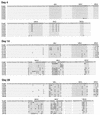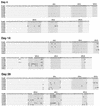Kinetics and in vivo induction of genetic variation of vlsE in Borrelia burgdorferi
- PMID: 9673250
- PMCID: PMC108403
- DOI: 10.1128/IAI.66.8.3689-3697.1998
Kinetics and in vivo induction of genetic variation of vlsE in Borrelia burgdorferi
Erratum in
- Infect Immun 1999 Jan;67(1):468
Abstract
The Lyme disease agent, Borrelia burgdorferi, is able to persistently infect humans and animals for months or years in the presence of an active immune response. It is not known how the organisms survive immune attack in the mammalian host. vlsE, a gene localized near one end of linear plasmid lp28-1 and encoding a surface-exposed lipoprotein in B. burgdorferi B31, was shown recently to undergo extensive genetic and antigenic variation within 28 days of initial infection in C3H/HeN mice. In this study, we examined the kinetics of vlsE sequence variation in C3H/HeN mice at 4, 7, 14, 21, and 28 days and at 7 and 12 months postinfection. Sequence changes were detected by PCR amplification and sequence analysis as early as 4 days postinfection and accumulated progressively in both C3H/HeN and CB-17 severe combined immunodeficient (SCID) mice throughout the course of infection. The sequence changes were consistent with sequential recombination of segments from multiple silent vls cassette sites into the vlsE expression site. No vlsE sequence changes were detected in organisms cultured in vitro for up to 84 days. These results indicate that vlsE recombination is induced by a factor(s) present in the mammalian host, independent of adaptive immune responses. The possible inducing conditions appear to be present in various tissue sites because isolates from multiple tissues showed similar degrees of sequence variation. The rate of accumulation of predicted amino acid changes was higher in the immunologically intact C3H/HeN mice than in SCID mice, a finding consistent with immune selection of VlsE variants.
Figures





References
-
- Baranton G, Postic D, Saint Girons I, Boerlin P, Piffaretti J-C, Assous M, Grimont P A D. Delineation of Borrelia burgdorferi sensu stricto, Borrelia garinii sp. nov., and group VS461 associated with Lyme borreliosis. Int J Syst Bacteriol. 1992;42:378–383. - PubMed
-
- Barbour A G. Antigenic variation of a relapsing fever Borrelia species. Annu Rev Microbiol. 1990;44:155–171. - PubMed
-
- Barbour A G. Linear DNA of Borrelia species and antigenic variation. Trends Microbiol. 1993;1:236–239. - PubMed
-
- Barbour A G, Fish D. The biological and social phenomenon of Lyme disease. Science. 1993;260:1610–1616. - PubMed
Publication types
MeSH terms
Substances
Associated data
- Actions
- Actions
- Actions
- Actions
- Actions
- Actions
- Actions
- Actions
- Actions
- Actions
- Actions
- Actions
- Actions
- Actions
- Actions
- Actions
- Actions
- Actions
- Actions
- Actions
- Actions
- Actions
- Actions
- Actions
- Actions
- Actions
- Actions
- Actions
- Actions
- Actions
Grants and funding
LinkOut - more resources
Full Text Sources
Other Literature Sources
Medical

